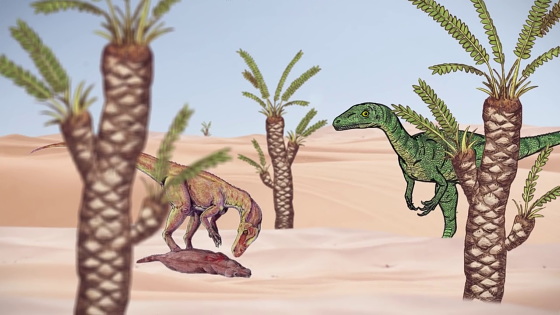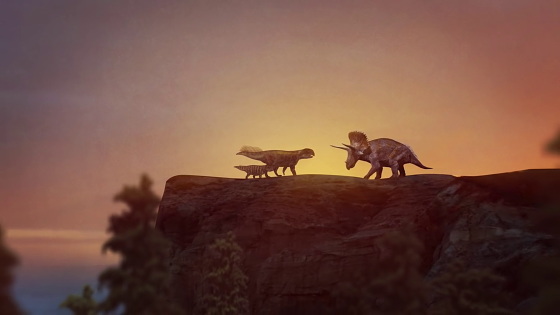"The era of rainfall over two million years & the period of increase in hazardous bombs" suddenly appeared on the earth when dinosaurs were born, resulting in a drastic change in the environment

In the history of the earth, which is said to be 4.6 billion years, the period of mass extinction of living creatures visits many times and "Global freezingA period of great change has been repeated over an extremely long time axis, as the era of ice came called. About 50 million years continued from 250 million years ago from nowTriassicIn the era of the age, the temperature was high and a very dry environment existed, but the amount of rain increased dramatically over 2 million years, the environment changed and the ecosystem changed drastically The times suddenly appeared.
That Time It Rained for Two Million Years - YouTube
To the earth of the era classified as 250 million years ago from the present time to the Triassic of the geological eraPangea ContinentThere was a supercontinent called called.

It is believed that in the inland part of the Pangea continent, which is said to have "all of the contemporary continents gathered" rarely rains, desolate deserts spread.

That situation changed drastically for 2 million years from 234 million years ago to 232 million years ago. This time is called "the Kanian floor", and it is known that sudden rainfall has suddenly increased suddenly all over the world.

Rain caused flooding around the world. What happened at this time seems to be small to medium-sized 'ordinary flood' instead of 'big flood' where many things flowed, but ordinary floods occur frequently over 2 million years By doing so, the environment surrounding the living thing suddenly changes. Therefore, during this period mass an extinction of animals called "the extinction of the Kanian floor" occurs.

From the Permian to the beginning of the Triassic, the Earth was very hot and dry. You can understand its traces by looking at the strata. The strata of this era mainly contains stones burned red and little traces of carbon indicating the existence of plants are hardly found.

In such a dry world, dinosaurs also existed. However, they are still believed to be in the world where early reptiles and mammalian ancestors live, both fighting for the place they live. What dominated the world at the time was carnivorous reptiles of the appearance like crocodiles,Kururushirizuwas.

One example is having a long hind legOrnithosoc. It is considered to be able to stand with two legs and was able to run fast when aiming at prey.

On the other hand, it is an ancestor of a mammalDickinonesAlso inhabited this era. It walks on limbsDimetrodonIt is considered to be a creature closer to modern mammals than it is.

In addition to this, many living creatures inhabited much from the Permian to the early Triassic years, thought to have adapted to the dry environment at that time at the time, but the major change that transformed it is 234 million It happened around the year.

The time before human beings are born is called "geological era", and each era is classified by analyzing the distribution of fossils and the features of the underground strata. In the early 1990s British research team discovered that there are layers with unexpected features in the Triassic strata which should be dry originally.

As mentioned earlier, the geology of the Triassic is red and features rocks that are not much weathered. However, the research team discovered that there were layers with rounded stones such as those made by the flow of the river, traces of deposits accumulated in the lake, and layers with plant debris as carbon . This means that rain fell on the ground and water was flowing, which means that there is a time when a lot of rain falls in the Triassic, which should be dry originally. As a result of detailed investigation, it has been revealed that the era actually extends to 2 million years.

Moreover, we know that this change has occurred in modern Britain in North America, from the Middle East to the Far East Asia. In other words, this climate change is not considered to be polar, it is believed to have occurred throughout the Pangea continent.

Eventually, this characteristic phenomenon came to be called "Carnian Pluvial Episode (CPE: Kanian Flooding Rainfall Event)".

The Kanian floor refers to the era that is located in the middle of the Triassic Period.

The average annual rainfall in the era when CPE occurred is estimated to be 1400 mm on average. This is about 4 times that of Utah State in the inland area of the USA. There is little rain throughout the year because Utah is in a dry area, but it will not be hard to imagine that the environment changes completely once it gets four times as rain as usual. Furthermore, considering that the average annual rainfall in Japan is about 1700 mm, it seems that it was not always the situation where rain pouring downward continues.

In this way, CPE is a time when the phenomenon that rain falls in a wide area of Pangea continent and flood occurs regularly for 2 million years.

Due to this climate change, a big change occurred on the earth. The biggest one that can be said is the large growth of dinosaurs. Among the vertebrate fossils discovered from the strata in the era before CPE began, the proportion of dinosaur fellows was about 5%.

However, in the strata near the end of the CPE, we know that the ratio has increased rapidly to 90%. This means that the number of dinosaurs increased on the ground during this 2 million years.

For what reason did the dinosaur suddenly increase? The reason is that the plants became huge than before by a lot of rain. In this era, as plants became huge due to climate change, the leaves that animals used as food have become higher than before. In this way, the short herbivorous animals became impossible to eat, and the number of individuals gradually declined gradually.

Also, Dickinodons were also herbivores, but they did not have teeth and moreoverGastrolithBecause I had swallowed stones and had no ability to help digestion, plants that I can eat were limited.

Investigating fossils of 'Different' fish of Dikino Don, it turned out that in the CPE era, Dickinodons were eaten only soft plants like ferns.

On the other hand, it has become evident that you were eating tree trunks from animals with teeth and animals that can use stomach stones.

In other words, in this era, the low and soft ferns of the shoulder changed to big trees due to climate change, and food circumstances surrounding animals changed greatly.

Furthermore, the chain continued, carnivorous animals that used foods such as Dicynodon as food were supposed to be reduced in number in this era.

Why on earth did such a major climate change occur? The answer was that a large eruption activity called "Wrangellian Eruptions" (Wrangell eruption) began in the area of British Columbia in the present Alaska and Canada, just before the CPE began 233 million years ago Yes.

This eruption activity lasted for 5 million years. The amount of lava flowed out was enormous, and the flowing lava was 6 km thick.

Due to the carbon dioxide released at that time, the temperature of the earth rose 3 degrees to 10 degrees Celsius. As the temperature rises globally, the amount of steam evaporating from the ocean gradually increases, and the precipitation increases accordingly. In other words, CPE was a phenomenon caused by the rise of volcanic eruptive activity triggered and increased rainfall over the millions of years time axis.

On the contrary, how did the end of this CPE era end?

In the age of CPE, the concentration of carbon dioxide in the air was very high, the situation lasted for millions of years. Then the plant grows bigger by absorbing more carbon dioxide. In this way, "Carbon fixation"Will be made.

In addition, carbon is absorbed in the rock eroded by rain and the ocean.

When the activity of Wrangler 's eruption approached the end, the emission of carbon dioxide declined. However, due to plant activity and absorption into the crust, which has been increasing due to the environment until then, carbon is gradually fixed and the atmospheric carbon dioxide concentration drops. Along with that, the world's rainfall gradually declined, finally the CPE ended.

The evidence reveals that the climate of the Pangea continent returned to a hot and dry state like before CPE when 230 million years ago when Wanger eruption activity was over. This situation continued until the division of Pangea continues 180 million years ago.

The era of CPE, which lasts about 2 million years, is only a few from the 4.6 billion year history of the earth. However, the changes that occurred during that era also formed the modern earth. For example, it was the result of CPE change that the tall plants so far changed and the tall plants such as coniferous forest appeared.

Also, as the rain declines and the era of CPE ceases to end, the Earth has reached the era of full-scale dinosaurs.

Related Posts:







